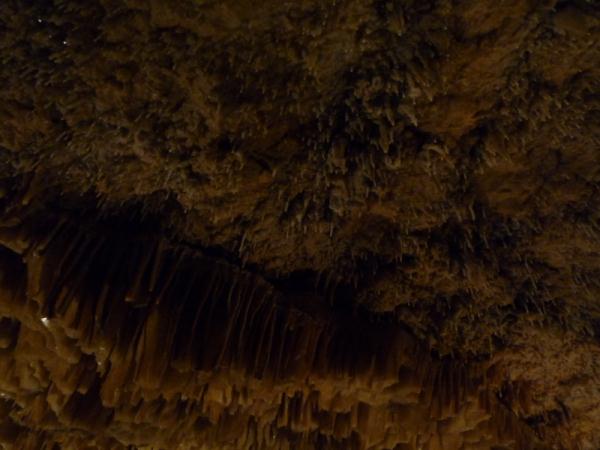
2008 this cave was opened for the audience at the first time.
The cave hasn’t got its name from present marble, but of the white colour of the flowstones.
In Istria this is very special, because the local soil is full of iron oxide which gives the flowstones a reddish colour. Flowstone was very well known to the people, but not so bright white.
So they believed, it must be marble.
The part of the cave, that can be visited is 93 meters long, 51 meters wide and 5 meters high.
The ceiling is full of little stalactites, so called “Maccharonis” even you can see real stalactites , whole curtains of stalactites, groups of stalagmites and columns with a diameter of 80 cm and the very rare helictites.
The local people knew this cave for a long time, graffitis from the year 1775 were found there.
At that time, a few of the flowstones were broken, the local people needed the freshwater hidden in the cave.
This freshwater was said to be very healthy because of its high concentration of calcium.
Even a few signs of the Bronze Age were found in this cave.
Two graves dated at this time can be seen in the cave, the are completely covered with flowstone.
The formation of flowstones:

Flowstones were generated from the deposition of minerals.
Water containing carbon dioxide flows through a rock containing calcium carbonate, a calcium bicarbonate solution develops.
If this solution reaches the ceiling of a cave, the air separates the carbon dioxide from the calcium carbonate by a chemical reaction, and the minerals can deposit at the place they appeared at the ceiling.
A little ring of calcite stays back, if the next drop flows down the same way, a little tube grows known as “soda straw” or “Maccharoni”, a “little” Stalactite.
When the water flows down at the outside of the tube the dripstone can expand to the width, the real stalactites grow.
When the drop falls down to the ground of the cave, the deposition of calcite builds towers, the so called stalagmites.
If the stalactite and stalagmite grow together after thousands of years we call it columns or stalagnates.
In the Marble cave you can even see little curtains of flowstone, they appear when the water flows down on a bevelled part of the ceiling, the calcite marks the way of the water until it falls to the ground.
The rather unknown helictites are a little phenomenon, there is no satisfying explanation of their development until now.
Helictites look if they had grown in zero gravity, the direction of growing changes.
They are mostly made of calcite and aragonite and are formed fine as needles, look crystalline and are very fragile.
 One theory says, that capillary forces gave them this extraordinary form, but this theory only works if there are very thin tubes in the helictites which can transport the water against the gravity, but the most helictites found aren’t hollow inside.
One theory says, that capillary forces gave them this extraordinary form, but this theory only works if there are very thin tubes in the helictites which can transport the water against the gravity, but the most helictites found aren’t hollow inside.
Another theory means, that the wind is the cause of the abnormal form, but this theory is problematic, too.
The direction of the wind in caves depends on air pressure outside, so it changes very often, but a flowstone needs a long time to grow (a few cm in 100 years) so it is very implausible that the wind blows to the same direction for so long time, and many caves with helictites have no entrances for wind, too.
The third theory says (Quotation of the wikipedia), “that slowly changing geological pressure causing stresses on the crystals at the base alters the piezo electrostatic potential and causes particle deposition to be oriented in some relationship to the prevailing pressure orientation.”
Helictites can be formed like fishhooks, saws, hands, corkscrews, they can look like “clumps of worms” , whole bushes and many other variations.
Maybe you feel like visiting the marble cave, now.
You can log this cache as a found if you took a photo of your gpsr (maybe with yourself, too) at the coordinates in front of the cave, and if you can answer the following questions:
(it is not necessary to visit the cave)
1. Why does the color of the flowstones range from rusty red to creamy white?
2. Why is it "forbidden" to touch the flowstones?
3. Which animal can be seen in the cave in addition to the bats, Latin name?
4. Which year Alberto Fortis visited this cave?
5. In which magazine 1898 a plan of the marble cave was published for the first time?
Send your reply to VTler.
Please enter your GC.com nickname in the subject of the mail.
Don't wait for log-permission, if your answers are not correct, we will contact you!
Dieser Cache ist unserem 100%igen Freund EDE gewidmet
